


Installation view of Sturtevant: Dialectic of Distance. Sturtevant Oldenburg Store at Thaddaeus Ropac London. Photo: Eva Herzog. © Estate Sturtevant, Paris. Courtesy Thaddaeus Ropac gallery, London · Paris · Salzburg · Seoul.
Thaddaeus Ropac Gallery, London
3 September – 29 October 2022
By ANNA McNAY
When The Store of Claes Oldenburg opened at 623 East 9th Street, Manhattan, New York City, in 1967, the eponymous artist, who had made The Store by Claes Oldenburg (note the prepositions) just a few blocks away in 1961, of which this was a recreation by the ballsy artist Sturtevant (1924-2014), reacted by cutting off contact with his copyist after attending her vernissage. He “freaked out,” Sturtevant recalls. “And he’d been very much in favour of my work. I said, ‘You can’t do that, Claes! You can’t be for me, and then be against me when I do your store.’” Additionally, Oldenburg’s dealer, Leo Castelli, is said to have felt so perturbed by Sturtevant’s pieces that he bought some purely in order to destroy them.1
On the 55th anniversary of this art-world fall-out, Thaddaeus Ropac is showcasing 14 of the objects and the advertising poster from Sturtevant’s store, alongside The Dark Threat of Absence (2002), a two-screen video work in which she re-enacts Paul McCarthy’s film Painter (1995).
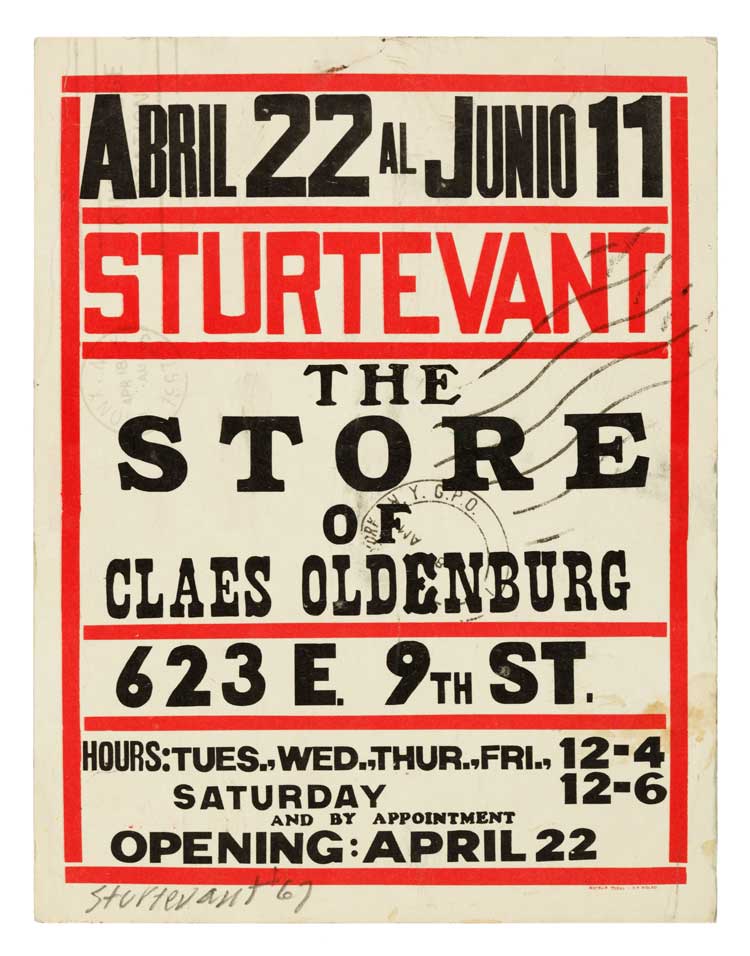
Sturtevant, The Store of Claes Oldenburg, 1967. Offset print on postal stamp (April 18, 1967) on cardboard, 17.7 x 13.7 cm (6.97 x 5.39 in). © Estate Sturtevant, Paris. Courtesy Thaddaeus Ropac, London · Paris · Salzburg · Seoul.
Born Elaine Sturtevant in 1924 in Ohio, the artist, who chose to drop her first name professionally so as to avoid gender-based assumptions about her work, was post-modern before post-modern became trendy. As Peter Eleey, the curator of her 2014 MoMA exhibition, says: “She was the first postmodern artist – before the fact – and also the last.”
Perhaps unsurprisingly, Sturtevant’s degrees were in psychology and philosophy, and she was a devoted fan of the French philosophers Gilles Deleuze (1925-95) and Michel Foucault (1926-84). She made frequent reference to them and their ideas, both in her work and when talking about her work. For example, she was consistently keen to emphasise that her works were not copies – aterm she found too static –, rather they were repetitions. “I was doing repetition before Deleuze wrote his Difference et Repetition,” Sturtevant proclaims in a short film on the Thaddaeus Ropac website (2012).2 Repetition, for Deleuze, can only describe a unique series of things or events. In her repetition of the works of other artists through her own actions and movements – always from memory – Sturtevant creates difference, also in the Deleuzian sense, namely the distance that simultaneously separates and connects two entities. As the art historian Anne Dressen explains: This doubling up in Sturtevant’s re-creations emphasises “the infrathin discrepancy” whereby “two peas in a pod cannot be identical, and every reprise puts restrictions on hyperrealism, because subjectivity inevitably creeps in.”3 Art is more often than not a source of repetition, since no artistic rendering of an object (or subject) is ever truly equivalent to other uses.
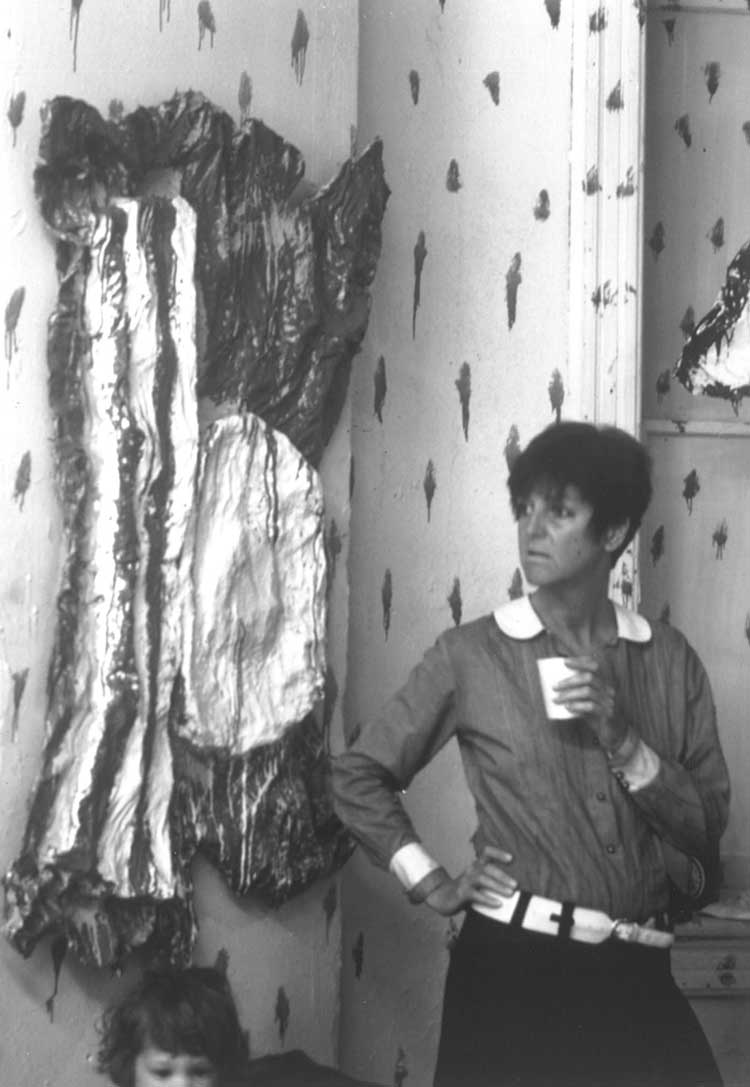
Sturtevant at her The Store of Claes Oldenburg, 1967. 623 East Ninth Street, New York. © Estate Sturtevant, Paris. Courtesy Thaddaeus Ropac, London · Paris · Salzburg · Seoul.
Oldenburg’s store, installed in Green Gallery in the winter of 1961, comprised individual sculptures of everyday consumer goods – food items, hardware and undergarments – made out of painted plaster. These were hung on the walls and laid out on tables and in vitrines. To advertise, he created business cards and posters, modelled on a black-and-red letterpress print poster he had seen in a Puerto Rican neighbourhood of New York. As a nod to this original, he retained the Spanish words for the dates. By selling his works directly in this manner, the artist obviated the need for a gallery. This installation has since been heralded as a milestone of pop art, highlighting the thin, and often tenuous, line between art and commodity.

Sturtevant, The Store of Claes Oldenburg, 1967. 623 East Ninth Street, New York. © Estate Sturtevant, Paris. Courtesy Thaddaeus Ropac, London · Paris · Salzburg · Seoul.
Sturtevant’s 1967 re-creation – brought to life here by a photograph, enlarged to “wallpaper” a dividing wall – was similarly installed, although her objects were disconcertingly inexact replicas. She, too, maintained the use of Spanish for the dates on her poster. This 2022 installation displays the 14 objects (including the poster) on the white gallery walls and on plinths of varying heights, thus a far cry from the storefront set up of the previous iteration(s). Of course, this exhibition is also a restaging of a restaging – thus one step further removed or differentiated from the original. It brings the objects full circle from their being art works of commodities, to being art works as commodities, to being art works of art works of commodities, to now being art works of art works of art works of commodities – and I feel sure there could be some more “as commodities” inserted into that statement as well!
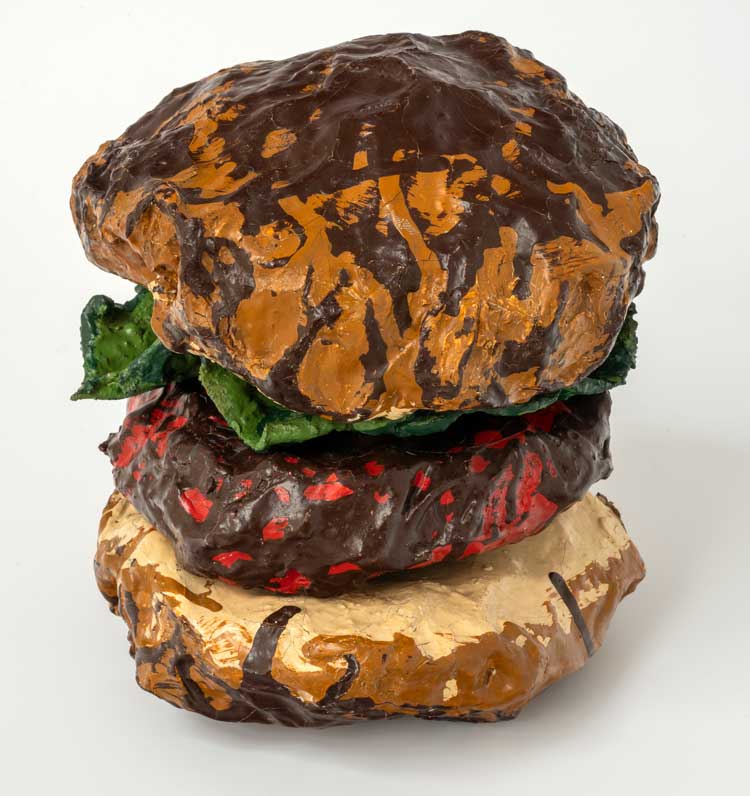
Sturtevant, Oldenburg store object, Hamburger and Lettuce on Plate, 1967. Chicken wire, cloth, plaster, enamel, 18 x 16 cm (7.09 x 6.3 in) (diameter). © Estate Sturtevant, Paris. Photo: Charles Duprat. Courtesy Thaddaeus Ropac, London · Paris · Salzburg · Seoul.
By displaying them on plinths, the gallery makes clear that these objects are both works of art and of considerable value. Quotidien food items are, in their plaster forms, elevated to high art. Furthermore, the variation in height of the plinths introduces the question of comparative or relative value, and these seemingly arbitrary choices (of plinth height) do not correlate in any way to the respective monetary values, or costs, of these items in shops or snack bars. The notion of commodification is therefore far from obliterated.
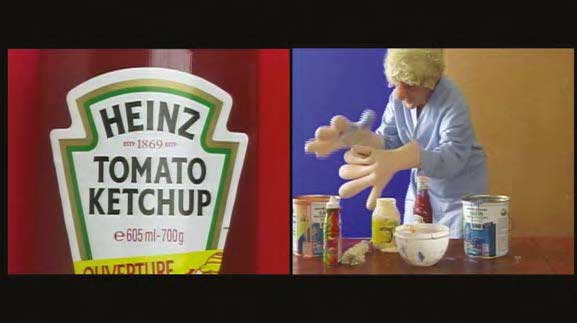
Sturtevant, Dark Threat of Absence, 2002. HD cam - metallic tape, two camera video 4/3 and 16/9, full wall projection displayed side by side with small gap between videos, RT: 14’37’’. Variable dimensions. © Estate Sturtevant, Paris.
And then there is The Dark Threat of Absence playing on a loop as the stage set. At just 14 minutes, 37 seconds long, it is much abridged in comparison to McCarthy’s Painter (50 minutes, 1 second). Additionally, whereas the original is a single-channel video, Sturtevant has chosen a two-screen format, with the left-hand screen revealing and exploring undercurrents from the main film. In Painter, McCarthy places himself – dressed in a blue artist’s smock, with a blonde wig and a number of prosthetics, including a bulbous nose and oversized rubber hands with sausage fingers – in an artist’s studio, containing several large canvases, oversized brushes and tubes and tins of paint. Throughout the film, he talks and acts in an exaggerated and comic fashion, repeating the name of Willem de Kooning, the hot-tempered, abstract-expressionist artist of whom this is generally considered a spoof. Midway through the film, the protagonist hacks at his hand with a meat cleaver, eventually succeeding in cutting off his index finger. The work has been understood as a caricature of the heroic yet tortured genius artist.
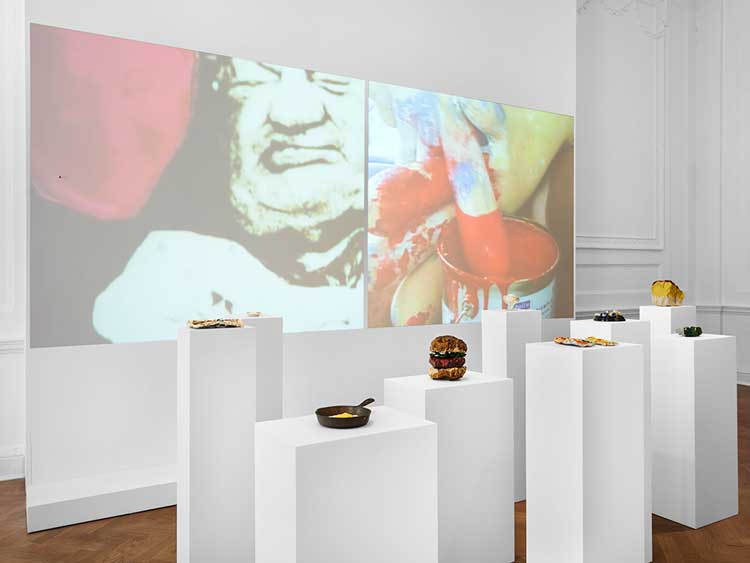
Installation view of Sturtevant: Dialectic of Distance. Sturtevant Oldenburg Store at Thaddaeus Ropac London, 2022. Photo: Eva Herzog. © Estate Sturtevant, Paris. Courtesy Thaddaeus Ropac gallery, London · Paris · Salzburg · Seoul.
In Sturtevant’s film, this critique is pushed still further, highlighting the phallocentric nature of the myth with – on the left-hand screen – explicit, sexual close-ups and cutaways to hysterical crowds at pop concerts as the painter severs his undeniably phallic digits, crying and groaning in pain. What is the equation here, one might ask. What it takes to bring about such a state of hysteria? The thin line between agony and ecstasy (a traditional subject matter for painters within the religious tradition)? Art as a means of both creation and destruction? Sturtevant’s painter additionally grabs hold of oversized tubes and bottles of ketchup and mayonnaise, which he mixes into his paint, adding the paralleling of art and food, already seen in The Store. And his repeated shouts of “Money, money, money! You owe me money! I want my money now!” (accompanied by deep breathing on the other screen) introduce, once again, the concept of art as a commodity.
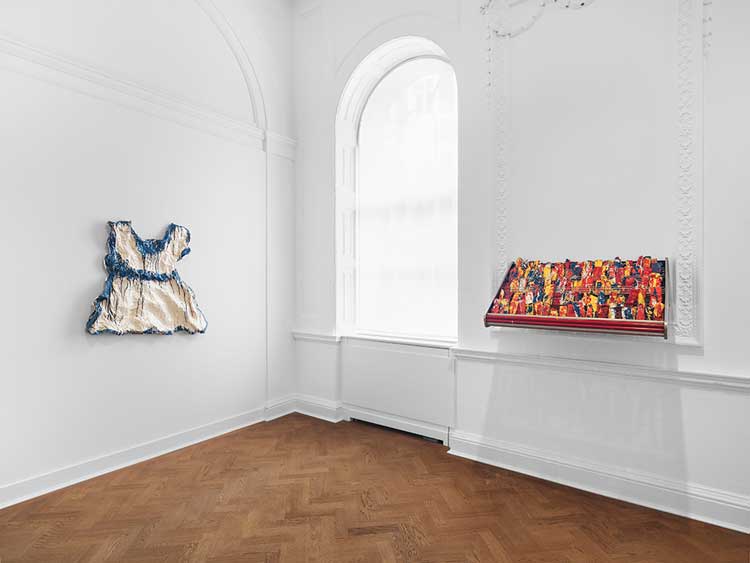
Installation view of Sturtevant: Dialectic of Distance. Sturtevant Oldenburg Store at Thaddaeus Ropac London, 2022. Photo: Eva Herzog. © Estate Sturtevant, Paris. Courtesy Thaddaeus Ropac gallery, London · Paris · Salzburg · Seoul.
Overall, The Dark Threat of Absence, particularly in adjunct to the objects from The Store, presents a satire of the art world at large. Although made more than half a century apart, the two works speak to and of the same primary themes – art as a commodity, and the relationship between art, sex (note also the deliciously, and yet suggestively, crumpled slip and dress on the walls of The Store), food and money – thus complementing one another and leading to deeper consideration than when staged alone. These parallels were perhaps succinctly expressed by the former director of the Metropolitan Museum of Art, Thomas Hoving, when, referencing the New York art scene of the 1960s, he exclaimed: “Art is money! Art is money-sexy! Art is money-sexy-social-climbing-fantastic!”
Above and beyond this, however, it has been argued that, rather than seeking solely to reveal the commodification of art, Sturtevant was closer in spirit to the Argentine writer Jorge Luis Borges’ fictional character Pierre Menard4, who re-creates several chapters of Miguel de Cervantes’ epic novel Don Quixote (1605), not by simply copying them, but by “becoming” Cervantes and channelling his work, while simultaneously remaining himself and therefore creating a new text. Similarly, Sturtevant might also have made her re-creations in order to understand the process that brought the original works into being. She alluded to this when she said: “Not stubbornly worrying about the resemblance alone but working towards an absent original in a convincing manner. Taking the same tools and the same colours. Understanding why and how it was done.”5
In the MoMA catalogue text from her exhibition in 1971,6 Sturtevant clearly stated what she was not:
“I am not Anti-Art
I am not saying anyone can do it
I am not ‘poking fun at the artist’
I am not in the process of celebrating process
I am not making copies
I am not making imitations
I am not interested in painting sculptures or objects
I am not interested in being a ‘Great Artist’
That’s real medieval thinking.”
Additionally, she said in an interview in 2013: “The appropriationists were really about the loss of originality and I was about the power of thought. A very big difference.”7 And indeed, it is clear that Sturtevant’s work was about much more than appropriation or copying. As Eleey recognised, she made style her medium. Thus her work is at once art and commodity, “thing” and thesis.
References
1. Sturtevant: Repeat Offender by Christopher Bagley, published 5 September 2014, www.wmagazine.com/story/sturtevant-moma-retrospective.
2. Difference and Repetition (1968) is considered one of Deleuze’s key publications and offers an exposition of his critique of identity, based on his definitions of the titular concepts, whereby difference implies divergence and decentring and repetition is associated with displacement and disguising.
3. Cited in the gallery text to accompany the exhibition.
4. Pierre Menard, Author of the Quixote is a short story by Jorge Luis Borges which was first published in Spanish in the Argentine journal Sur in May 1939.
5. Sturtevant, cited in Label Elaine by Bernard Blistène, in Sturtevant: The Brutal Truth, edited by Bernard Blistène and Mario Kramer, and published by Hatje Cantz Publishers, 2005, page 37.
6. Cited in Dangerous Concealment: The Art of Sturtevant by Peter Eleey, in Sturtevant: Double Trouble, New York, Museum of Modern Art, published in 2014, page 54.
7. Sturtevant: Leaps Jumps and Bumps, video by Ivan Ogilvie, published 25 July 2013, www.nowness.com.